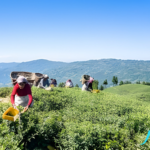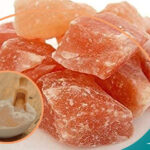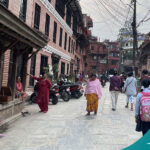Nepal is renowned for its vibrant culture, breathtaking landscapes, and mouth-watering cuisine. Among the many famous dishes in Nepali cuisine, none is more popular or beloved than Dal Bhat. It is a staple food in Nepal and is served in almost every household, hotel, and restaurant nationwide.
Dal Bhat is a traditional Nepali dish that consists of steamed rice, lentil soup, and various side dishes. This hearty meal is not only a favourite among Nepalis but also enjoyed by people worldwide. It is often considered the unofficial national dish of Nepal.
In this article, we will explore the rich history and cultural significance of Dal Bhat. We will delve into the ingredients that make this dish unique and provide a step-by-step guide on preparing it at home. We will also share tips on where to find the best Dal Bhat in Nepal and the variations of this famous Nepali cuisine. So, immerse yourself in Nepali cuisine and discover why Dal Bhat is a must-try dish for anyone.
History of Dal Bhat
The history of Dal Bhat dates back centuries, and the dish has evolved into the beloved Nepali cuisine that it is today. Dal Bhat is a staple food in Nepal and an essential part of Nepalese culture and tradition. We will explore the origins of Dal Bhat and its historical and cultural significance in Nepal.
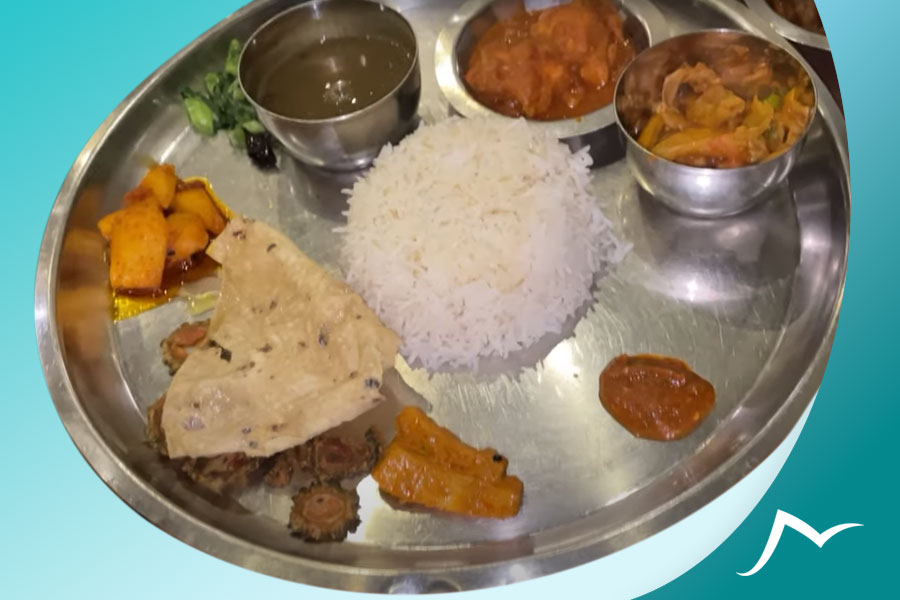
Origins of the dish and how it evolved over time
The exact origins of Dal Bhat are not known, but it is believed to have originated in the Kathmandu Valley region of Nepal. The dish was initially a simple meal of steamed rice and lentil soup eaten by farmers and labourers in the region. Over time, the dish evolved to include various side dishes, such as vegetables, meat, and pickles.
Historical and cultural significance of Dal Bhat in Nepal
Dal Bhat has deep historical and cultural significance in Nepal. It is a symbol of hospitality, community, and togetherness. In Nepalese culture, guests are considered a form of God, and serving them, Dal Bhat, is a sign of respect and honour. Nepalese people also believe that sharing food with others brings good luck and strengthens relationships.
Moreover, Dal Bhat has played a crucial role in Nepalese agriculture and food security. The dish is made from locally sourced ingredients, and the production of rice and lentils is an essential part of the Nepalese economy. Therefore, Dal Bhat is not only a favourite dish among Nepalis but also a significant contributor to the country’s food security.
Comparison with similar dishes in neighbouring countries
Dal Bhat is not unique to Nepal, and similar dishes can be found in neighbouring countries such as India, Pakistan, Bangladesh, Bhutan, Sri Lanka, Burma and many others. In India, for example, the dish is called “Dal Chawal” and is typically made with basmati rice and various lentils. In Pakistan and Bangladesh, the dish is known as “Khichdi” and is made with rice, lentils, and spices.
However, despite the similarities, Dal Bhat has some distinct differences from similar dishes in neighbouring countries. For instance, the lentil soup in Dal Bhat is typically made with various lentils, whereas in India, it is often made with a single type of lentil. Additionally, the side dishes accompanying Dal Bhat vary across Nepal, including anything from vegetables to meat and fish.
Ingredients of Dal Bhat
Dal Bhat is a popular Nepalese dish loved by many for its rich taste and nutritional value. Here, we will delve into the ingredients of Dal Bhat, the variations of the dish across Nepal, and the nutritional benefits of its components.
Explanation of the main ingredients and their role in the dish
The main ingredients of Dal Bhat are rice and lentil soup, commonly known as “dal.” The soup is made with a combination of lentils, such as yellow lentils, red lentils, and black lentils. For a unique flavour, the lentil soup is seasoned with various spices, including cumin, coriander, turmeric, and chilli powder.
In addition to lentil soup and rice, Dal Bhat typically includes a variety of side dishes. The side dishes can range from vegetables, such as spinach, and potatoes, to meat, such as chicken, goat, or buffalo. Other side dishes commonly served with Dal Bhat include pickles, papadum (thin, crispy bread), and chutneys.
Different variations of Dal Bhat across Nepal and its regions
Variations of the Dal Bhat can be found in different regions of Nepal. In the western region, the dish is often served with a side of buckwheat bread, while in the eastern region, it is typically served with a side of boiled vegetables.
In the Terai region of Nepal, located in the southern part of the country, Dal Bhat is often made with a mix of lentils and is spicier than the version served in other regions. In the hilly regions of Nepal, on the other hand, the dish is often made with a lighter lentil soup and is filled with more vegetables.
Nutritional value of the dish and health benefits of its ingredients
Dal Bhat is a nutritious dish with a balanced combination of carbohydrates, protein, and fibre. Lentil soup is a good source of protein, while rice provides carbohydrates necessary for energy. The dish also contains essential vitamins and minerals, such as magnesium, iron, and vitamin B.
The ingredients in Dal Bhat are also associated with several health benefits. Lentils, for example, are a good source of plant-based protein and are linked to lower cholesterol levels, improved digestion, and better heart health. Rice is a gluten-free grain that is easy to digest and provides sustained energy.
Moreover, the vegetables served with Dal Bhat are packed with vitamins, minerals, and antioxidants essential for good health. For example, spinach is rich in iron and calcium, while potatoes are a good vitamin C and potassium source.
Different Types of Rice Used in Dal Bhat
Long Grain Rice
Long-grain rice is a type of rice that has slender grains that are four to five times longer than their width. It’s a popular choice for Dal Bhat because it absorbs liquids without becoming sticky. This characteristic of long-grain rice makes it an excellent option for making fluffy, separate rice grains.
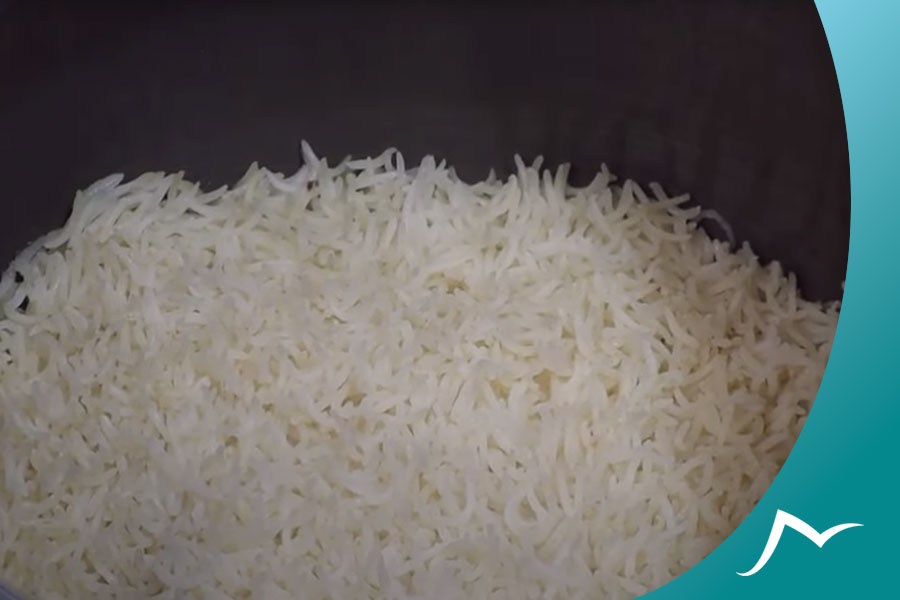
Basmati Rice
Basmati rice is a fragrant, long-grain rice commonly used in Indian cuisine, including dal bhat. Its long, slender grains have a slightly nutty flavour and a distinct aroma that can be likened to popcorn or roasted nuts. Basmati rice is typically used in biryani and pulao dishes, but it can also be paired with dal bhat for a delicious and aromatic meal.
Jetho Budho Rice
Jetho budho is a type of short-grain rice that is native to Nepal. It is known for its soft texture and slightly sweet flavour and is often used in traditional Nepali dishes such as sel roti. When used in dal bhat, jetho budho rice provides a mild sweetness that complements the spiciness of the lentil soup.
Kalijira Rice
Kalijira rice, or baby basmati or Indian rice, is a short-grain rice commonly used in Indian and Nepali cuisine. Its delicate texture and slightly floral aroma make it a popular choice for desserts and sweet dishes. Kalijira rice provides a subtle sweetness that pairs well with the savoury lentil soup.
Black Rice
Black rice, also known as forbidden rice, is a short-grain rice native to China. It is high in antioxidants and has a slightly nutty flavour and a chewy texture. When used in dal bhat, black rice adds a unique colour and texture to the dish and boosts nutrition.
Marsi Rice
Marsi rice is a sort of Black rice. This type of rice is native to Nepal and is commonly used in traditional dishes like dal bhat. Short-grain rice is very starchy and has a sticky texture when cooked. Marsi rice has a unique aroma and flavour.
Red Rice
Red rice is a variety of rice commonly grown in Southeast Asia, particularly Thailand and Bhutan. It has a nutty flavour and a slightly chewy texture and is rich in antioxidants and other nutrients. When used in dal bhat, red rice adds a pop of colour and a unique flavour that complements the lentil soup.
Brown Rice
This type of rice is whole grain rice with its bran layer intact. It has a nutty flavour and chewy texture. Brown rice is an excellent source of fibre and nutrients such as magnesium and selenium. It takes longer to cook than white rice, but it can be a healthier option as it is less processed.
Overall, the variety of rice used in dal bhat can significantly impact the flavour and texture of the dish. From fragrant basmati rice to nutty black rice, each type brings its unique characteristics to the table.
Different Types of Lentils Used in Dal Bhat
Lentils are a staple ingredient in Nepali cuisine and are an essential part of the daily diet of many Nepalese. These legumes are a rich source of protein, fibre, and essential nutrients, making them an excellent addition to any meal. Various types of lentils are used in Nepali cuisine, each with unique taste, texture, and nutritional benefits.
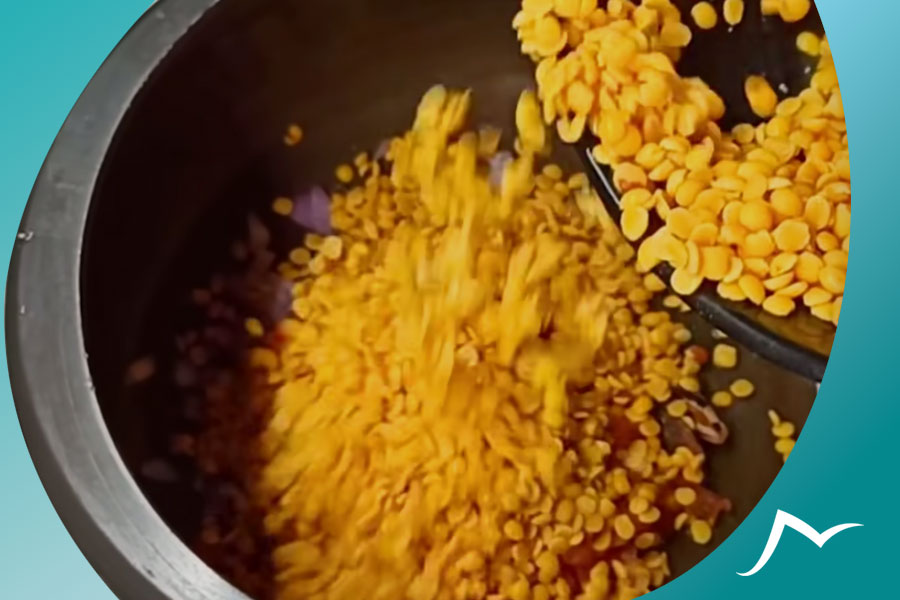
Masoor Dal
Masoor Dal, known as red lentils, is the most common lentil used in Nepali cuisine. It quickly, making it a popular choice for dals and soups. Masoor Dal is an excellent source of protein, fibre, and iron.
Mung Dal
Mung Dal, also known as yellow lentils, is another commonly used lentil in Nepali cuisine. It is small, round, and has a sweet, nutty flavour. Mung Dal is an excellent source of protein, fibre, and essential nutrients such as folate and magnesium.
Chana Dal
Chana Dal, also known as split chickpeas, is a more significant type of lentil with a more robust flavour than Masoor Dal or Mung Dal. It is commonly used in soups, stews, and curries and is an excellent source of protein, fibre, and essential nutrients such as iron and zinc.
Urad Dal
Urad Dal, also known as black lentils, is a small, black lentil with a white interior. It is commonly used in soups, stews, and curries and is an excellent source of protein, fibre, and essential nutrients such as potassium and magnesium.
Rajma
Rajma, known as kidney beans, is a more significant type of lentil with a more robust flavour than other lentils. It is commonly used in soups, stews, and curries and is an excellent source of protein, fibre, and essential nutrients such as iron and potassium.
Mash Dal
Mash Dal, also known as white lentils, is a larger type of lentil with a milder flavour than others. It is commonly used in soups, stews, and curries and is an excellent source of protein, fibre, and essential nutrients such as iron and magnesium.
Rahar Dal
Rahar Dal, also known as split pigeon peas, is a larger type of lentil with a more robust flavour than Masoor Dal or Mung Dal. It is commonly used in soups, stews, and curries and is an excellent source of protein, fibre, and essential nutrients such as folate and potassium.
The different types of lentils used in Nepali cuisine offer a range of unique flavours, textures, and nutritional benefits.
Variety of Vegetarian and Non-Vegetarian Dal Bhat
In Nepal, Dal Bhat is widely eaten in vegetarian and non-vegetarian forms. Among non-vegetarian options, three popular varieties of Dal Bhat are commonly consumed in Nepal- Chicken Dal Bhat, Mutton Dal Bhat, and Fish Dal Bhat. There are also many options for vegetarians. Here are varieties of vegetarian and non-vegetarian dal bhat popular in Nepal:
Non-Vegetarian Dal Bhat
Chicken Dal Bhat
Chicken Dal Bhat is a popular non-vegetarian version of Dal Bhat in Nepal. To make this dish, local chicken is cooked with spices like cumin, coriander, turmeric, and ginger-garlic paste. The lentil soup is poured over the steaming hot rice and served with vegetables like sautéed spinach or bitter gourd.
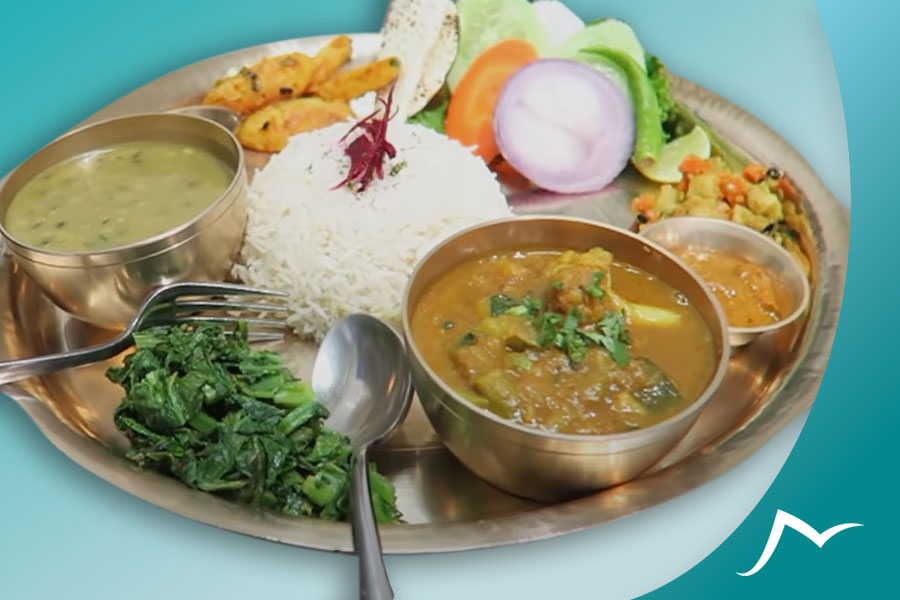
Mutton Dal Bhat
Mutton Dal Bhat is another delicious and hearty non-vegetarian version of Dal Bhat. This dish has slow-cooking mutton and spices like bay leaves, cloves, cinnamon, and cardamom. The result is a rich, flavorful, meaty broth served over steaming hot rice and vegetables like cauliflower or eggplant.
Fish Dal Bhat
Fish Dal Bhat is a popular non-vegetarian option in coastal regions of Nepal. For this dish, fish is cooked with spices like mustard seeds, fennel seeds, and cumin powder. The result is a flavorful and tangy broth poured over rice and served with vegetables like potato and spinach.
Vegetarian Dal Bhat
Plain Dal Bhat with Vegetables
This is the simplest and most common vegetarian dal bhat meal. It consists of boiled rice, lentil soup, and various vegetables such as potatoes, green beans, spinach, and cauliflower. The side dishes are usually prepared with a blend of spices and served with ghee (clarified butter) and curd.
Aloo Tama Bodi Dal Bhat
This is a unique vegetarian dal bhat dish from Kathmandu valley and the hilly regions of Nepal. Aloo tama bodi dal bhat is made with black-eyed peas, bamboo shoots (tama), and potatoes (aloo). The dish is flavoured with cumin, coriander, and turmeric. It is served with boiled rice, papadum, and curd.
Gundruk Dal Bhat
Gundruk dal bhat is a traditional Nepalese dish with fermented leafy vegetables known as gundruk. The lentil soup in this dish is made with a combination of gundruk, lentils, and spices. This dal bhat is served with boiled rice, papadum, and curd.
Saag Dal Bhat
Saag dal bhat is a popular Nepalese dish with lentils and various leafy greens. Some popular leafy greens are mustard, Chamsur and leafy spinach greens. The lentil soup is flavoured with different spices, including cumin, coriander, and turmeric. The dish is served with boiled rice, papadum, and curd.
Paneer Dal Bhat
Paneer dal bhat is a delicious vegetarian dal bhat dish made with lentil soup and chunks of paneer (cottage cheese). The dish is flavoured with cumin, coriander, and turmeric. It is served with boiled rice, papadum, and curd.
Kwanti Dal Bhat
Kwanti Dal Bhat is a special version of Dal Bhat prepared during festivals like Janaipurnima. It includes a variety of beans and lentils that are soaked and sprouted for a few days before cooking. The lentil soup is flavoured with a blend of spices like fenugreek, cumin, and mustard seeds, and the steamed rice is served with a side of boiled vegetables and pickles.
There are many variations of this dish available for vegetarians. There is something for everyone, from plain dal bhat with vegetables to unique words like gundruk dal bhat and aloo tama bodi dal bhat.
Preparation of Dal Bhat
Here we will cover the preparation of Dal Bhat, including step-by-step instructions, traditional and modern cooking methods, common mistakes to avoid, and tips for adjusting the recipe to personal taste preferences.
Step-by-step instructions on how to cook Dal Bhat
To prepare Dal Bhat, you will need the following ingredients:
- 1 cup of rice
- 1 cup of lentils (yellow or red lentils are commonly used)
- Water
- Salt
- Oil or ghee
- Spices (cumin, coriander, turmeric, chilli powder)
Here are the steps to cook Dal Bhat:
- Rinse the rice and lentils in cold water until the water clears.
- In a pot, combine the rice and 2 cups of water. Bring to a boil, then reduce the heat to low, cover the pot, and let it simmer until the rice is cooked (usually takes about 15-20 minutes).
- In another pot, combine the lentils and 4 cups of water. Add salt and spices according to your taste preferences. Bring to a boil, then reduce the heat to low, cover the pot, and let it simmer until the lentils are soft and cooked (usually takes about 30 minutes).
- Once the rice and lentils are cooked, heat some oil or ghee in a pan and add some spices. Fry the spices until fragrant, then add the cooked lentils and mix well.
- Serve the lentil soup with the cooked rice and your choice of side dishes.
Traditional cooking methods vs modern techniques
Traditionally, Dal Bhat was cooked over a wood-fired stove, which gave it a unique smoky flavour. However, the dish can be prepared more quickly and easily with modern cooking techniques, such as electric stoves, gas stoves and pressure cookers.
While traditional methods may take longer, they offer a unique flavour that modern techniques cannot replicate. Therefore, it is up to personal preference which way to use it.
Common mistakes to avoid when cooking Dal Bhat
One common mistake when cooking Dal Bhat is using too much water, which can result in a soupy consistency. It is important to use the correct ratio of rice and lentils to water to achieve the desired texture.
Another mistake is to be correctly seasoning the lentil soup. Using the right amount of salt and spices is essential to enhance the dish’s flavour.
Tips for adjusting the recipe to personal taste preferences
One of the great things about Dal Bhat is that it can be easily adjusted to personal taste preferences. For example, some prefer a spicier lentil soup, while others prefer a milder or plain flavour. Adjusting the number of spices used in the recipe can achieve this.
Similarly, the choice of side dishes can be adjusted to personal taste preferences. For example, some people prefer to serve the dish with more vegetables, while others prefer more meat. Adding or subtracting side dishes can accommodate these preferences.
Serving Dal Bhat
Serving Dal Bhat is an integral part of the Nepali food culture. It is not just about the taste but also about the customs and traditions surrounding it. Here, we will look closer at how Dal Bhat is typically served in Nepal, how to plate and garnish it properly, and what common accompaniments are filled with it.
Traditions and customs of serving Dal Bhat in Nepal
Dal Bhat is typically served twice daily in Nepal – once in the morning for brunch and again in the evening for dinner. It is often eaten using the right hand, as is the custom in many South Asian countries.
In Nepal, it is common for guests to be served first, and it is considered polite to offer second helpings. It is also customary to eat everything that is served, as wasting food is frowned upon. In many Nepali households, the head of the family will serve the Dal Bhat to the rest of the family, and it is not uncommon for people to eat together from a shared plate.
How to properly plate and garnish Dal Bhat
When it comes to plating and garnishing Dal Bhat, there are a few essential things to remember. First and foremost, it is important to have a large enough plate to hold all of the different components of the dish. You must ensure you have enough space to accommodate everything.
To plate the dish, spoon a generous serving of rice onto the plate. Next, add a ladle of dal (lentil soup) on top of the rice, and then add a scoop of the vegetable or meat curry on the side. You can also sprinkle fresh herbs, such as cilantro or parsley, on top of the dish for added flavour and colour. Lentil soup is also served in a separate bowl.
Common accompaniments to Dal Bhat, such as chutneys and pickles
Dal Bhat is often served with various accompaniments, such as chutneys and pickles. One popular accompaniment is tomato achar, a spicy tomato chutney that adds a tangy flavour to the dish. Another common accompaniment is a mixed pickle, a mix of different vegetables that have been pickled in vinegar or lemon juice.
Other common accompaniments include curd(yogurt), papadums, and achar (pickles made from different vegetables). These accompaniments are often served on the side, and diners can add them to their Dal Bhat as desired.
Serving Dal Bhat is not just about the taste but also the surrounding customs and traditions.
Dal Bhat and Nepalese Culture
Dal Bhat, the beloved dish of Nepal, is not only a staple of the Nepalese diet but also an essential part of its culture and tradition. From festivals to daily meals, Dal Bhat is present in every aspect of Nepalese life. Let’s explore the cultural significance of this famous Nepali cuisine.
How Dal Bhat is an essential part of Nepalese culture and tradition
Dal Bhat in Nepal is a meal and a way of life. The dish holds a special place in the hearts of Nepalese people, and it is considered the national food of Nepal. It is a comfort food cherished by all Nepalese, regardless of socioeconomic status. It is an essential part of Nepalese culture and tradition and is deeply ingrained in the Nepalese way of life.
Festivals and occasions where Dal Bhat is commonly served
Dal Bhat is served during various festivals and occasions throughout the year. During Dashain, the biggest festival in Nepal, it is common for families to gather and enjoy a hearty meal of Dal Bhat. Similarly, during Tihar, also known as the festival of lights, families enjoy a traditional meal of Dal Bhat with homemade sweets. Also, Dal Bhat is a popular choice for the main course during weddings, parties, and other social gatherings.
Significance of Dal Bhat in Nepalese households and communities
Dal Bhat is a meal and a unifying force in Nepalese households and communities. It is a dish that brings people together and strengthens their bonds. It is a symbol of hospitality, and it is common for Nepalese households to serve Dal Bhat to their guests as a sign of respect and generosity. In many rural areas of Nepal, Dal Bhat is also offered to travellers as a gesture of goodwill and hospitality.
Role of Dal Bhat in Nepalese agriculture and food security
Dal Bhat plays a crucial role in Nepalese agriculture and food security. In Nepal, where most of the population relies on agriculture for their livelihood, Dal Bhat is a simple yet nutritious meal that provides the necessary energy and sustenance for hardworking farmers. The ingredients used in Dal Bhat, such as lentils, rice, and vegetables, are easily accessible and affordable, making it an ideal meal for families living in rural areas. The government of Nepal also recognizes the importance of Dal Bhat in food security and has implemented various programs to promote the production and consumption of rice and lentil grains.
Role of Thakali restaurants to promote Dal Bhat in Nepal
Thakali restaurants have become famous throughout Nepal and other countries with Nepalese communities. Thakali is an ethnic group from the Mustang district of Nepal. Thakali cuisine is known for its flavorful dishes, typically served with rice, including lentils, vegetables, and meat such as mutton or chicken.
Thakali restaurants have played a crucial role in promoting Dal Bhat, the staple food of Nepal. Focusing on traditional Nepali cuisine, these restaurants have become popular destinations for locals and tourists. Thakali restaurants not only serve delicious food but also provide a unique dining experience highlighting Nepali culture.
One reason Thakali restaurants have successfully promoted Dal Bhat is their commitment to using fresh and locally sourced ingredients. They take pride in using traditional cooking methods and spices to create authentic Nepali flavours that customers love. This dedication to quality has helped Thakali restaurants earn a reputation as a trustworthy source of delicious and healthy food.
Another way Thakali restaurants have promoted Dal Bhat is by offering various options to suit different dietary needs. Vegetarian and vegan versions of Dal Bhat are readily available, as are non-vegetarian versions that include chicken, mutton, and fish. In addition to Dal Bhat, Thakali restaurants also serve a range of side dishes such as pickles, chutneys, curries, Curd, Ghee and Papad, all of which complement the main course perfectly.
Thakali restaurants have not only promoted Dal Bhat within Nepal but also overseas. Many Nepali restaurants abroad have adopted the Thakali style of cooking, so Dal Bhat has become a popular dish in many countries.
Where to Find Dal Bhat in Nepal
Dal Bhat is undoubtedly the most famous and beloved cuisine of Nepal. It is a staple food widely consumed by Nepalese people of all ages and social backgrounds. Dal Bhat is a food and a way of life deeply ingrained in Nepalese culture and tradition. For those planning to visit Nepal and experience its authentic food, knowing where to find the best Dal Bhat is essential.
Popular restaurants and eateries that serve Dal Bhat
Nepal offers a wide range of restaurants and eateries that serve Dal Bhat all over, from valley and tarai to hilly regions. Some popular restaurants known for their delicious Dal Bhat include Jimbu Thakali, Bhancha Ghar, Jehto Budho khana, Krishnarpan Restaurant, Bhojan Griha, and Newari Kitchen. These restaurants offer a fine dining experience and are known for their authentic and traditional Nepalese cuisine.
In addition to the high-end restaurants, numerous local eateries serve Dal Bhat at an affordable price.
Tips for finding the best Dal Bhat in Nepal
To find the best Dal Bhat in Nepal, it is essential to look for the following factors:
Freshness
Always look for a restaurant or eatery that serves fresh and hot Dal Bhat. Freshness is the key to the perfect taste of Dal Bhat.
Cleanliness
Ensuring that the restaurant or eatery maintains proper hygiene and cleanliness while preparing and serving the food is essential.
Authenticity
Look for a restaurant or eatery that offers authentic and traditional Nepalese cuisine. Authenticity is essential to experience the authentic taste of Dal Bhat.
Price
While the price may not be the most crucial factor, looking for a restaurant or eatery that offers value for money is always good.
Finding the best Dal Bhat in Nepal can be daunting, given the abundance of options available. However, following the tips mentioned above, you can find the most authentic and delicious Dal Bhat that will leave you craving more.
The cost of Dal Bhat in Nepal
The cost of dal bhat in Nepal can vary depending on several factors, including the restaurant’s location, the type of restaurant, and the quality and quantity of the food. Generally, a basic vegetarian dal bhat meal can cost anywhere from NPR 100 to NPR 400 (approximately USD 0.85 to USD 3.40). This would include rice, lentil soup, a small portion of vegetable curry, and a side dish.
On the other hand, a non-vegetarian dal bhat meal that includes meat such as chicken or goat can cost anywhere from NPR 300 to NPR 1000 (approximately USD 2.50 to USD 8.00), depending on the location and quality of the restaurant. This typically includes rice, lentil soup, a small portion of meat curry, a vegetable side dish, and perhaps some pickles or papad.
It’s important to note that these prices are only a rough estimate and can vary depending on several factors, including the location and quality of the restaurant, the season, and any additional services or amenities offered by the restaurant.
FAQs
What makes Dal Bhat in Nepal so popular?
Dal Bhat is a staple food in Nepal due to its affordability, simplicity, and nutritional value. It is also a significant part of Nepalese culture and tradition.
What are the nutritional benefits of Dal Bhat?
Dal Bhat is a high-carbohydrate, high-protein dish providing sustained energy and is a good source of essential vitamins and minerals.
Can Dal Bhat be made vegetarian or vegan?
Yes, Dal Bhat can be made vegan or vegetarian by omitting any meat or dairy products in the recipe.
What are the different variations of Dal Bhat in Nepal?
There are many variations of Dal Bhat across Nepal, depending on the region and availability of ingredients. Some variations include adding spices, different types of lentils, or incorporating meat or fish.
What are some common accompaniments to Dal Bhat?
Common accompaniments to Dal Bhat include pickles, chutneys, yogurt, and vegetables such as potatoes, spinach, or tomatoes.
Is Dal Bhat spicy?
The level of spiciness in Dal Bhat can vary depending on the recipe or the region in which it is prepared. Some versions are spicier than others.
Can I find Dal Bhat in restaurants outside of Nepal?
Yes, Nepali restaurants in many parts of the world serve Dal Bhat, along with other Nepali dishes.
How do I properly plate and garnish Dal Bhat?
To properly plate Dal Bhat, start by placing a serving of rice in the center of the plate, followed by a ladle of lentil soup on top. Arrange any accompanying vegetables or chutneys around the edges of the plate.
Can I make Dal Bhat ahead of time?
Yes, Dal Bhat can be made ahead of time and stored in the refrigerator for a few days. Reheat it in the microwave or on the stove before serving.
Is Dal Bhat a gluten-free dish?
Yes, Dal Bhat is a gluten-free dish, as long as any accompanying bread or roti is also gluten-free.
Can I substitute other grains for rice in Dal Bhat?
While rice is the traditional grain used in Dal Bhat, other grains, such as quinoa or millet, can be substituted for a healthier twist.
Conclusion
In conclusion, Dal Bhat is more than just a dish in Nepal – it symbolizes Nepalese culture and tradition. From its humble origins as a simple meal for farmers and labourers, it has become a beloved and iconic cuisine representing the country’s rich heritage. We explored the history and evolution of Dal Bhat, its nutritional value and ingredients, and the preparation and serving methods. We also delved into its significance in Nepalese culture and agriculture.
If you ever find yourself in Nepal, try Dal Bhat at one of the many restaurants, eateries, street vendors, or local markets. You can customize your meal by adding your preferred level of spiciness, and it is often served with a variety of sides, such as pickles, chutneys, and curries.
In summary, Dal Bhat is a must-try dish for anyone interested in exploring the rich culinary traditions of Nepal. So why take the opportunity to experience it yourself on your next trip to Nepal? Whether you cook it yourself or enjoy it at a local restaurant, you will undoubtedly appreciate this famous Nepali cuisine’s unique flavours and cultural significance.

